📋 Introduction to Stock Options for Employees
💡 Opening Context
“In a competitive corporate world, retaining skilled employees and ensuring their motivation is critical for organizational success. Employee Stock Option Plans (ESOPs) have emerged as a popular tool to align employees’ interests with company growth, fostering loyalty and productivity.”
📜 Topic Background
The concept of ESOPs originated in the United States as a means of rewarding employees while boosting their motivation through company ownership. In India, ESOPs became prominent during the early 2000s, particularly in startups and tech companies. The tool incentivizes employees by offering company shares at discounted rates, linking their efforts to business success.
📊 Quick Facts and Key Statistics
- 📈 ESOP Adoption in India: 25% of mid-large companies offer stock options, primarily in IT and startups.
- 🔒 Retention Impact: Companies offering ESOPs reported 60% higher retention rates over five years.
- 🚀 Startups and ESOPs: 90% of Indian unicorns use ESOPs for employee retention.
- 💰 Wealth Creation: Infosys’ early ESOP program turned employees into millionaires, boosting company culture.
- 🌎 Global Perspective: In Silicon Valley, over 75% of tech companies provide ESOPs to align employee incentives.
👥 Stakeholders and Their Roles
- Employers: Offer ESOPs as a strategic tool for retention, motivation, and company growth.
- Employees: Gain ownership, linking their performance to company profitability.
- Investors: Support ESOPs to align workforce interests with long-term value creation.
- Government: Regulates ESOP taxation and frameworks to balance equity-based compensation practices.
✅ Achievements and Challenges
Achievements:
- 💡 Boosted Motivation and Loyalty: Linking rewards to company success creates a performance-driven culture.
- 💰 Wealth Creation for Employees: Infosys’ ESOP success in the 1990s showcased how employees benefit financially.
- 🔒 Reduced Attrition: Tech firms like Flipkart reduced attrition by 30% after implementing ESOP policies.
- 📊 Alignment with Organizational Goals: Employees develop a stakeholder mindset, prioritizing long-term objectives.
Challenges:
- 📉 Liquidity Concerns: Employees face challenges monetizing shares in unlisted or early-stage startups.
- ⚠️ Uncertainty in Share Value: Volatility in stock markets or company performance can devalue options.
- 💸 Taxation Issues: ESOP taxation at the time of exercise can deter employee enthusiasm.
🌍 Global Comparisons
- 🇺🇸 Silicon Valley: Companies like Google and Amazon effectively use ESOPs for wealth creation and motivation.
- 🇮🇳 India: Startups like Zomato and Ola attract top talent by offering attractive ESOP packages.
Case Study: Infosys’ ESOP Program – Infosys’ early implementation of ESOPs made several employees millionaires, showcasing the power of equity-based compensation to align interests.
📚 Structured Arguments for Discussion
- Supporting Stance: “Offering ESOPs aligns employee performance with company growth, fostering loyalty and creating a sense of ownership.”
- Opposing Stance: “ESOPs carry risks of volatility and taxation burdens, which can reduce their effectiveness in motivating employees.”
- Balanced Perspective: “While ESOPs are a powerful tool for retention and motivation, they must be well-structured with liquidity and taxation clarity to maximize their benefits.”
💬 Effective Discussion Approaches
- Opening Approaches:
- 📊 Statistical Impact: “90% of Indian unicorns offer ESOPs to retain top talent, reducing attrition significantly.”
- 📜 Case Study Opening: “Infosys’ ESOP success demonstrates how equity-sharing fosters loyalty and long-term value.”
- Counter-Argument Handling:
- Challenge: “Stock value volatility deters employees.”
- Rebuttal: “Proper financial education and strategic implementation of ESOPs can mitigate this risk.”
🧐 Strategic Analysis of Strengths and Weaknesses
- Strengths: Boosts motivation and aligns employee goals, attracts and retains skilled talent, promotes wealth creation and loyalty.
- Weaknesses: Volatility in share value, liquidity and taxation issues.
- Opportunities: Increased adoption in growing sectors like fintech and e-commerce, leveraging ESOPs for mid-level management retention.
- Threats: Mismanagement leading to loss of trust, declining stock values affecting employee morale.
📖 Connecting with B-School Applications
- Real-World Applications: Strategic HR management, understanding the valuation and taxation of stock options, addressing employee rights as minority shareholders.
- Sample Interview Questions:
- “How do ESOPs influence employee motivation and loyalty in a startup ecosystem?”
- “Discuss the risks and benefits of ESOPs in retaining top talent.”
- Insights for B-School Students: Study successful ESOP implementations (e.g., Infosys, Flipkart), explore case studies where ESOPs failed due to poor valuation strategies.


